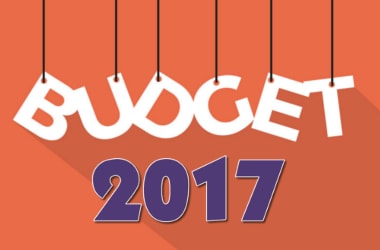
Budget 2017 - 10 main focuses
For the very first time, the union budget for financial year 2017-18 was presented on 1st of February, while previously the budget was always presented on 28th or 29th day of February. Finance Minister Arun Jaitley presented the budget with greetings of Vasant Panchmi in Lok Sabha on Wednesday. This is the fourth budget presented by the Modi government. Various innovative measures as well as changes can be seen in it. Jaitley is said to have taken immense pride in presenting a joint budget which includes the Railway Budget as well.
The top themes of the budget:1. DemonetizationThe effects of demonetization will not extend to the next year. It is however expected to have a transient impact on lives of people and Indian economy. Jaitley termed Demonetization as a bold and decisive measure that will lead to higher growth in GDP.
2. Rural lifeSpeaking about prime target, the government aims to bring 1 crore households out of poverty by 2019. Under MNREGA scheme, five lakh farm ponds will be taken up during 2017-18. Women participation under MNREGA is expected to go up to 55%. The scheme will be under space technology supervision to ensure work performance. Under Pradhan Mantri Gram Sadak Yojana, Rs. 19,000 crore will be allocated. By March 2017, the country is expected to achieve 100% rural electrification. Swachh Bharat mission has made an immense progress; sanitation coverage has shown rise from 42% in Oct 2013 to 60% now.
3. Agriculture areaFarmers are assured credit of Rs. 10 lakh crore with 60 days interest waiver and they must feel secure against all types of natural calamities. There is increase in NABARD fund to Rs. 40,000 crore. For soil testing, government will set up mini labs in krishi Vigyan Kendras. A proper model law on contract farming will be effectively prepared and shared with the states. Along with these, issuance of soil cards has gained momentum.
4. Youth’s interestThere would be a system to measure annual learning outcomes and innovative fund for secondary education will be opted simultaneously. It is time to focus on 3,479 educationally-backward blocks. Based on accreditation, colleges will be identified and courses on foreign languages are likely to be introduced. Skill India mission was launched to maximize potential and it is expected to set up 100 India International centers across the country.
5. Railway and InfrastructureFor infrastructure a sum of Rs. 39,61,354 crore is allocated and for railways it is Rs. 1,31,000 crore. No Service charge on tickets booked through IRCTC. By 2020, unmanned level crossings will be totally eliminated. Initiatives will be taken to commission 3,500 km of railway from 2,800 km last year. Passengers will be provided SMS-base “clean my coach service” and Coach mitra facility to register all coach related complaints. By 2019 all trains will have bio-toilets. Competitive ticket booking facility will be provided to the passengers. New metro rail policy will be announced accordingly. The total allocation of Highway is Rs. 64,000 crore. Provisions for high speed internet will be taken to facilitate 1,50,000 gram panchayats.
6. For poor and health careUnder nationwide scheme, pregnant women will get Rs. 6000 each. The allocation for Mahila Shakti Kendras is Rs. 500 crore. A sum of Rs. 1,84,632 crore is allocated for children and women. By 2025, steps will be taken to eliminate tuberculosis. Around 1.5 lakh health sub centres will be transformed into health wellness centres. Two AIIMS will be opened in Gujarat and Jharkhand. Senior citizens will be issued Aadhaar-based smartcards to monitor health.
7. Fiscal situationTotal expenditure is Rs. 21,47,000 crore. Focus will be on capital expenditure(which is 25.4%) and, plan, non-plan expenditure will be abolished. For implementing the budget announcements, Rs. 3000 crore is assigned under the Development of Economic Affairs. For science and technology, expenditure is Rs. 37,435 crore. Rs. 4.11 lakh crore is the total resources transferred to states and Union Territories.
8. Political parties fundingThe maximum cash donation amount to any political party will be limited to Rs. 2000 cash from any source. However, they can receive donation by digital mode or cheque from donors. An amendment is being proposed to the RBI act so as to enable issuance of electoral bonds. These bonds can be purchased by donors from banks or post offices through digital transactions or cheque.
9. Financial sectorProvisions will be taken to list Shares of Railway PSE like IRCTC on stock exchanges. There will be a computer emergency response team for financial sectors. For 2017-18, Pradhan Mantri Mudra Yojana lending target fixed at Rs. 2.44 lakh crore. BHIM app will unleash mobile phone revolution an there will be two more upcoming schemes to promote BHIM app. Tranquil online booking system for military and defense personnel will also be taken.
10. Tax ProposalsThe budget speaks India’s tax to GDP ratio is no fortunate. Only 5.97 lakh firms out of 13.14 lakh registered companies have filed returns for 2016-17. 1.95 crore individuals showed an income between Rs. 2.5 lakh to Rs. 5 lakh. Only 1.72 lakh people showed income above Rs. 50 lakh a year. Since partial demonetization, deposits ranging from Rs. 2 lakh to Rs. 80 lakh were made in 1.09 crore accounts. Holding period for long term capital gain will be lowered to 2 years. The income tax act is to be amended to ensure that no transaction above Rs 3 lakh is permitted in cash.
The Finance Minister did a good job focusing in major key sectors. A significant boost to investment in rural sectors and focus on tax base is ensured. It was reassuring to note that the technology platform development for GST is on schedule. At a time when the country’s economy has been facing breezes of weak demand, infirm private investment, etc., the budget for 2017-18 is expected to give a boost to intake and investment besides gesturing constancy, simplicity and stability